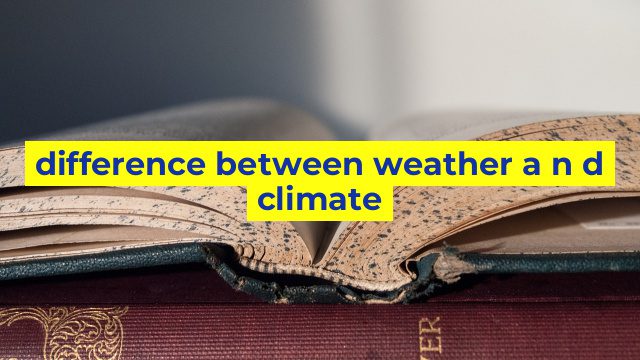The Difference Between Weather and Climate
Introduction
Weather and climate are two terms often used interchangeably to describe atmospheric conditions. However, despite their similarities, there are significant differences between the two. Weather and climate may be related, but they are not the same thing.
Understanding Weather
Weather refers to the current atmospheric conditions of a particular place at a particular time. These conditions include temperature, precipitation, wind speed, humidity, and atmospheric pressure. Weather can change very quickly and can differ from one location to another, even if they are only a few miles apart.
For example, if it’s sunny and warm in one location, it may be raining and cold in another just a few miles away. Unlike climate, which refers to long-term averages of weather patterns, weather is a short-term phenomenon that can change hourly or daily.
Understanding Climate
Climate refers to the average weather conditions of a particular region over a long period of time, usually spanning 30 years or more. Climate encompasses a wide range of factors, including temperature, precipitation, sunshine, wind, and atmospheric pressure.
Climate can be thought of as a long-term pattern of the weather. For instance, if a region is known for having hot and dry summers and cold and snowy winters for decades, then it is part of that region’s climate.
Unlike weather, climate is slow and steady, and it takes a long time for it to change. That’s why we can’t say with certainty what the climate will be like on a particular day, but we can make long-term predictions about how climate change will alter the weather patterns of a region.
Conclusion
In summary, weather and climate are two related, but distinct, concepts. Weather refers to the current atmospheric conditions of a particular place, while climate refers to the long-term patterns of weather over a region. Understanding these differences is essential for predicting and managing the impacts of global climate change. By studying and comparing weather and climate, we can build a better understanding of weather patterns and how the changing climate is influencing them.
Table difference between weather a n d climate
| Category | Weather | Climate |
|---|---|---|
| Definition | The current atmospheric conditions at a specific place and time | The average weather conditions over a long period of time in a specific area |
| Timeframe | Short term | Long term |
| Measurement | Temperature, wind, precipitation, humidity, and pressure measurements | Average temperature, precipitation, and other weather patterns over a period of at least 30 years |
| Location | Specific to a particular place and time | Describes the weather patterns of a larger area over a longer period of time |
| Impacts | Impacts daily life, transportation, and outdoor activities | Impacts agriculture, natural resources, and long-term planning |

